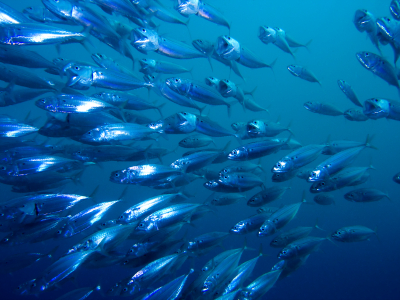It’s been almost a month since the Deepwater Horizon exploded and began spewing oil into the Gulf of Mexico. But it’s not your typical oil spill; because of its depth and distance from shore, it has so far brought no images of fouled beaches or blackened, dead sea birds.
Whatever damage is being done by the viscous soup floating under the sea is still largely unknown. But more and more scientists are fearing the worst, reports Justin Gillis in The New York Times. The researchers who’ve had the closest look beneath the surface ratcheted up the anxiety when they described giant underwater plumes of oil as large as 10 miles long and three miles wide. Said scientist Samantha Joyce:
There’s a shocking amount of oil in the deep water, relative to what you see in the surface water. There’s a tremendous amount of oil in multiple layers, three or four or five layers deep in the water column.
What the oil spill and the dispersants being used to break it up mean for marine life in the Gulf — short term and long term — is anybody’s guess. But it has all the makings of an ecological disaster. Writes Joel Achenbach in The Washington Post:
The millions of gallons of crude, and the introduction of chemicals to disperse it, have thrown this underwater ecosystem into chaos, and scientists have no answer to the question of how this unintended and uncontrolled experiment in marine biology and chemistry will ultimately play out.
In fact, as Bettina Boxall and Alana Semuels point out in the Los Angeles Times, the chemicals being dumped into the sea to break up the oil may only be making things worse under the surface.
The widespread spraying of chemical dispersants on the surface slick may be compounding exposure and speeding oil uptake into the food chain, scientists warned. The problem, said George Crozier, executive director of the Dauphin Island Sea Lab, is that it is easier for particle-munching microorganisms to ingest the broken-up bits of oil.
Grist’s Tom Philpott has also been digging up the ugly story behind the dispersants.
And the Christian Science Monitor‘s Mark Sappenfield goes a step farther, raising the specter of huge dead zones created by lack of oxygen in the water.
… serious environmental degradation could take place in the open ocean, creating massive “dead zones” where no creature can live because of the lack of oxygen in the water. The spread of oil at all levels of the Gulf also could become a concern for shore communities in hurricanes, which stir up the water column as they come ashore.
Thar she blows
Meanwhile, in a galaxy far away, aka Wall Street, experts can also only speculate as to how this disaster will play out in their world. It may come down simply to which way the wind blows. Worst-case scenario, according to investment adviser David Kotok, is that the slick moves west, where the majority of oil-producing wells in the Gulf are located, which might lead to fire hazards. If drilling platforms in the area have to be abandoned, “[a]bout 31 percent of our domestic oil supply will be shut off,” he says. “You can imagine the impact on fuel prices.” But if the slick moves east, well, that’s not so great either. Here’s the take from FireDogLake.



